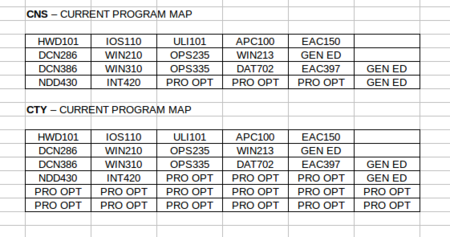CNS / CTY Curriculum Development
Contents
CNS/CTY Streams (Development Framework)
The purpose of this resource is to use a WIKI as a repository to create a transparent, efficient on-line framework (tool) to assist in CNS/CTY Curriculum development. This WIKI will branch out into several streams for analysis / development. The CNS/CTY PAC (Program Advisory Committee) meetings have been held several times during 2014. This committee consists of management, faculty, industry professionals, and former CNS/CTY students that meet to review and discuss the current curriculum and recommend or advise any changes that may need to be made. It is the intension of this WIKI to provide a collection point for ideas and collaboration between courses for the CNS/CTY program.
Curriculum Development Framework by Stream
- [ Hardware ]
- [ Database ]
- [ OPS (Operating Systems) ]
- [ Security (sideline stream) ]
- [ Cloud Computing ]
- [ Advanced Data Communications ]
Overview / Direction
Recommendations From Recent PAC Meetings:
[ CNS/CTY Curriculum: Discussion Transcript ]
- The curriculum discussions for the CNS/CTY programs have drawn attention to several key areas:
(Note current and proposed CNS/CTY curriculum maps display below)
- Create an identical skill base for both CNS and CTY programs for the first four semesters
- Students in the CTY program (after completing co-op) sometimes want to graduate with CNS and fail to see the point of taking an additional 2 semesters. The problem is that when students are enrolled in the CTY program, the CTY program requires them to complete the 6 semesters. A number of students will accept employment without having completed the CTY diploma certificate (this affects the perception of student success and retention). Creating an identical skill base for both CNS and CTY programs will offer employers with a minimum level of employee competence and provide a conduit for students to pursue the CTY diploma certificate if desired.
- Increase retention of CTY students by offering real IT industry projects within the fifth and sixth semesters
- With identical core requirements for the first four semesters of the CNS/CTY programs, the fifth and sixth semester of the CTY program can roll-out courses to allow students to develop a better understanding of the industry by working with an IT company or organization on a related task (referred to as a "capstone project"). By allowing students to with an industry partner for at least two semesters, the student is encouraged to complete the CTY program.
- Promote student success by channeling them to a one year, lower credential diploma (with the option of re-applying to CNS/CTY upon successful completion)
- There has been discussion in curriculum meetings to channel cns/cty students that are unsuccessful in their first semester to transfer to obtain a one Year (reduced credit) Diploma certificate. This course would provide the minimum (essential) skills for students to work in basic job categories in the IT industry. Students that successfully complete this program may be allow to re-apply to the CNS/CTY program.
- Align hardware concepts to reflect data servers (eg. data centers) as well as desktop (client-server) models
- Subject matter experts in the CDOT applied research division have indicated gaps from what students learn and what is currently adopted in the IT industry. One example would be students, although having skills to create Ethernet cables for workstations, lack the subtle skill to wire a server rack. In an effort to eliminate this discrepancy, newer course will be introduced to deal with these issues including infrastructure, advanced data communications, advanced firewalls, and security. One suggestion is to split the NDD430 course into two separate courses, the first emphasizing infrastructure and the second emphasizing configuring a server and running services. The hardware course will be separated into two separate courses, the first focusing on the desktop, and the second to focus on data centers. In addition, a course in project management is recommended to be added as a government curriculum requirement.
- Perform Curriculum Review for CNS/CTY Streams
- Review Courses in CNS/CTY Program Streams to ensure up-to-date content (meeting latest operational trends in industry), consistency with learning outcomes, resources, development of IT skills, and flow among courses within the stream.
Current vs Proposed CNS/CTY Curriculum Map
The Challenge (Things to Consider)
- Curriculum development can seem like a daunting task! On one hand, it is important for curriculum to grow and develop in order to take advantage of changing trends and help to better train our students for industry. On the other hand, great care must be taken to not make changes in course curriculum without considering the impact on other courses, and to make certain that content and learning skills are maintained in the learning outcomes for courses until a major curriculum review and possible curriculum revisions are warranted. Other challenges include limited time frames for all faculty to meet at the same time to discuss curriculum issues.
- Meeting Minutes for CNS/CTY PAC Committee Meetings
- Curriculum Development Forms
- ICT Curriculum Review 2012
- Updating Programming Stream (Example of CPA/CPD Curriculum Development on WIKI)

